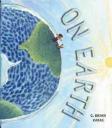G. Brian Karas’ book On Earth is dedicated to explaining the Earth’s daily and yearly cycles, as well as the Earth’s orbit, rotation, and tilt that contribute to these cycles. Karas also sheds light on how and why we have the given seasons and what makes the day time light, and night time dark. Though the concepts are complex in nature, the book aims to describe them in a simple, poetic way in order to help children form a general understanding. This gentle, child-friendly method is exemplified often throughout the book. Take for example, Karas’ explanation of night where he states that “at night we turn away from the sun and see a universe of stars and planets while we dream of what we can do tomorrow.” The information is not presented in a typical fashion, whereby all parts are connected. Instead, to assist in child comprehension, Karas utilizes a step-by-step approach so as to focus on elements loosely and individually. The author’s main goal appears clear: Have young readers think big concepts that are old in time.
Curriculum Connections
On Earth is an exceptional tool for use in early elementary classrooms. The text is simple and pleasing, while the illustrations are vibrant, detailed, and helpful. As previously stated, children are forced to begin thinking about complex concepts and procedures. Chances are, these topics will be confusing and overwhelming to begin, but in the way Karas presents the information, the book is a great place to start. The distinctively colorful, sometimes sideways pictures are intriguing and draw readers in, while the diagrams and text work to explain the brilliant images with simple words and phrases. The book does a great job introducing elements that contribute to the understanding of the relationship between Earth and sun, changing of the seasons, how day turns to night, etc…(Virginia Standards of Learning 3.8 a). Young children can also relate to the occurrences in the book. For example readers see other children going to school as the seasons change…just as they do, celebrate birthdays as years progress…just as they do, and stand by small trees in their growth stages…just as they do. The more a child can relate, the more easily he/she can understand the difficult concepts.
Additional Resources
- This link provides teachers with a helpful, fun lesson explaining how Earth’s rotations contribute to day and night. Children will love this experiment and it can work with all age groups!
- This interactive extended dictionary for kids helps children to actually see the solar system and click on various elements for an in-depth explanation. It provides facts, pictures, and definitions. In addition to highlighting Earth and the sun, it can also be helpful for lessons on outer space as it extends well beyond the two basic elements.
- This site provides a fun activity for children to utilize online to better understand Earth’s rotation, its position, time between rotations, etc…It is interactive and presents the correct answer automatically after children give the questions a try first!
Book: On Earth
Author/Illustrator: G. Brian Karas
Publisher: Puffin Books, A Division of The Penguin Group
Publication Date: 2008
Pages: 32 pages
Grade Range: Recommended K-3
ISBN: 978-0-399-24025-6

